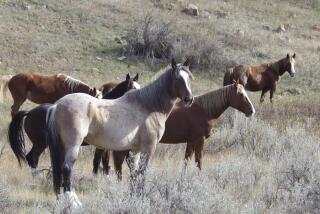Immigrants of all stripes occupy New World, crowding out native species. Success stories are few. : Wild Horses Attain Symbolic Status, but Trample Parts of West
- Share via
ALBUQUERQUE, N.M. — Wild horses with flaring nostrils and flashing manes are the defiant free spirits of the West.
But they are invaders, too, damaging land and making it uninhabitable for native species that have evolved over thousands of years.
The wild horses found in 10 western states claim diverse origins. Some are descended directly from the first modern horses brought to the New World by the Spanish conquistadors about 500 years ago. Others are from herds that were managed and culled by ranchers who sold the horses to the U.S. Cavalry at the turn of the century.
Although they aren’t natives--horse ancestors disappeared from the continent more than 11,000 years ago--they have taken well to their new home.
They reproduce like coyotes and have few natural predators, says Bud Cribley, the Bureau of Land Management’s senior wild horse and burro specialist in Washington, D.C. With a reproduction rate of about 19% a year, a herd can double its population in three or four years, he said.
“The population essentially would increase unchecked until the horses eat themselves out of house and home,” Cribley said. “We have to keep in mind wild horses were not a part of the ecosystem in the West.”
The United States has a wild horse population of about 39,470 animals, according to 1998 BLM figures, the most recent available. The BLM, which manages the herds, estimates the land they live on can support about 22,778 animals. Roughly 16,500 animals are classified as “excess.”
The most visible problem caused by horse overpopulation is competition for forage that would be eaten by ranchers’ cattle--invaders themselves. A 1999 study by Cornell University researcher David Pimentel estimates that about $5 million per year in forage is lost to wild horses.
Nevada has by far the most wild horses of any state, said Terry Woosley, leader for the BLM’s wild horse and burro program in Nevada. The horses there, which are reproducing faster than the bureau’s adoption program can remove them, have clashed with some federally listed threatened and endangered species.
Wild horses have tramped through and eaten vegetation along the banks of streams that are home to the Lahontan cutthroat trout, a threatened species that is native to Nevada. In some areas, they helped destroy the trout’s habitat.
Horses were removed from some areas or fenced out. Woosley said grazing animals of all types--from cattle to elk--also have contributed to the problem.
Wild horses and burros also eat forage favored by the endangered Mojave Desert tortoise, which lives in Arizona and Nevada. A program began last year to remove horses and burros from tortoise habitat, said Kelly Grissom, wild horse and burro specialist with the Arizona BLM office in Phoenix.
Decades of grazing, fire and other disturbances have changed the type of vegetation on the range to plants the tortoises don’t eat.
Good range management has created its own problems for the wild horses.
“The better we manage them, the longer they live and the better they reproduce,” Cribley said. “It kills us from the management perspective.”
Solutions to the problem are limited by a law Congress passed in 1971 known as the Wild Free Roaming Horse and Burro Act. The act protects wild horses and burros from capture, branding, harassment or death and sets out the maximum penalty of a $2,000 fine and a year in jail.
The only control methods allowed by federal law are rounding up animals for adoption and placing the older, unadoptable horses onto private land in Oklahoma leased by the BLM for use as a sanctuary.
The BLM is helping to subsidize private research into animal contraceptives, but that solution is still a long way off, Woosley said.
More to Read
Sign up for Essential California
The most important California stories and recommendations in your inbox every morning.
You may occasionally receive promotional content from the Los Angeles Times.













